
Golden Oyster mushroom
I listened to an interview featuring James Low on my short drive to the trailhead. His illuminating descriptions of Dzogchen and Buddhist teachings had lulled me into a quasi-meditative state as I donned my day pack and headed north along the Flat River. The solitude of the trail and the comfortable mid-70s temperatures, which seemed to suppress any insect distractions, only deepened my meditative state as I followed my little adventure route that combines authorized and not-so-authorized trails to reach a fun point where I can ford the river. River crossings have a way of getting me deep into a flow state, especially when done solo. The concentration required to avoid losing my balance or slipping on a rock, combined with the open awareness of the sounds of flowing water, the cooling breeze, the waterfowl, the feel of the slightly cool water as it creeps ever higher on my legs, all combine to bring on that experience of "at-one-ment", as John Vervaeke would call it. The crossing went smoothly enough, and as I hiked on toward the next section of the hike involving a short field crossing, I stopped to photograph a couple of nice Golden Oyster mushrooms growing from a downed branch. Still alone, I worked my way along the edge of the field, now part of a disc golf course, then back to the main trail leading to the little settlement of Fallasburg. There I crossed the covered bridge and set out on the final leg, the more upland Loop Trail that would take me back to my truck.

Golden Oyster mushroom
The temperature was now getting upward of 80°F, and some gnats were beginning to buzz about, favoring the inconvenient spot right in front of my face. I stopped to inspect a new bat house that had been donated to the park by the Boy Scouts, then picked up my pace a little, climbing deeper into the woods. My contemplative state was only mildly interrupted by the need to brush away the little gnats. Apparently, the distraction was enough, because suddenly my face and upper body were wrapped in a large spider web! Wild thrashing about settled down into slightly less panicked plucking of strands from my face, head, and shoulders. As I regained my composure, I happened to glance down to the front of my left shoulder, where, slightly too close for my eyes to focus completely, there appeared to be a rather good-sized spider clinging to a larger, web-encased insect. Seizure!!! Unable to shed my shirt due to the pack on my back, I frantically searched for a stick, before trying a combination of blowing and finger-flicking, neither of which was sufficient to dislodge my well-adhered opponent. Finally, a desperate sweep with the back of my hand broke the bonds that secured it to my shirt, and I breathed out a heavy sigh of relief—short-lived though it would be—for the creature and its prey were now clinging to the back of my hand. The thrashing resumed, nearly sufficient to sprain my wrist. At last, I was free of my tormentor. Perhaps James would suggest that it was free of me. Regardless, the world was once again in a finer state of affairs! In a moment of self-reflection, I realized how thankful I was to be solo hiking—nobody needed to witness my embarrassing encounter.
I, a much wiser hiker now, searched out a large stick with which to fan the remainder of the trail ahead of me, until I returned to the open meadow and the short walk back to the river to rinse off my sandals, before returning to my truck. A fine morning indeed!
[Addendum, August 21, 2025: I found out today the beautiful Golden Oyster mushrooms I found are considered an invasive species in North America. Apparently, they originated in Asia and came to the United States as home mushroom raising kits around 2010. They are known to reduce mushroom diversity in areas where they become established by out-competing native species.]
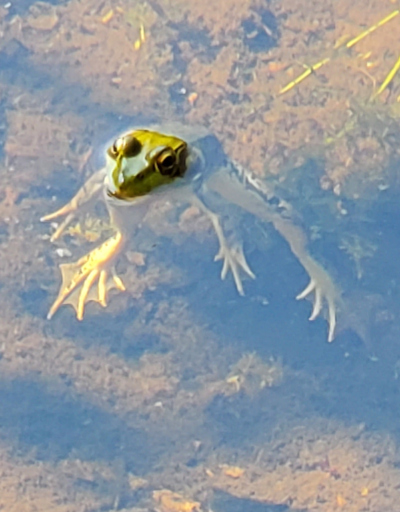
Frog, hanging around in the pond.
This image is best viewed by humming, "Hangin' around, hangin' around" to the tune of "Stayin' Alive" by the BeeGees.
Two nights ago, just after sunset, there was a massacre onboard S.V. Lotus. More than twenty large eight-legged enemies met their death, mostly by fly swatter impact, directing them into the waters of Muskegon Lake. Several others succumbed to chemical warfare. By morning, the scarcity of webs reflected the success of the night-time raid conducted under the light of the attacker's headlamp.
The Torah's Exodus reports the seventh of of Yahweh's commandments recorded by Moses as being, Thou shalt not kill.
Presumably, based on additional writings in the same text, this applies to murder, with several exceptions (Wikipedia lists murder, incest, bearing false witness (perjury) in proceedings of a capital charge, adultery, idolatry, bestiality, child sacrifice to pagan gods, cursing a parent, fortune-telling, and other sins). It was clearly a dangerous time to be alive. I feel relatively safe that I had not broached that commandment.
The Buddhists were significantly broader in their prohibition. The first of the Five Precepts, the commitment to "abstain from taking life", prohibits killing any sentient being, a rule that applies to humans, animals, and insects. This prohibition is rooted in the concepts of non-violence (ahimsa), loving-kindness (metta), and compassion (karuna). I'm clearly in trouble here, certainly resulting in karmic consequences.
I find myself much more aligned with the Objectivist version of morality, where the focus is on the value of life, but context is everything, and the only "commandment", as Ayn Rand wryly called it, is to think, i.e. to be rational. I suspect the killing fields that engulfed our tiny ship on that night fell well within her ethics.
Anyway, today we atoned for any violence committed on that fateful night by reveling in the life surrounding us on our hike through the Wittenbach-Wege trail system. We paused often to admire the wildflowers and tall grasses or to discover the identity of some unknown plant using Google Lens (a case where bringing technology into nature only elevates the experience). Ah, yes, that bush is the invasive species Autumn Olive, but who knew the berries were edible? [Unfortunately, that discovery might mean more death and destruction at home.] The cycle of life was embodied in a decaying fallen tree we've watched return to soil over tens of years of hiking, its remains now supporting the growth of new vegetation.
One of the plants we were seeking to discover was the source of little tiny "stick-tights" that we had found in the past clinging to our legs from walks around our property, but after several false negatives, we decided that identification would have to wait until we returned home. We did discover there are a lot of versions of what people call "stick-tights," just not the ones we were seeking.
At the end of our walk, we had fun playing with the frogs in the pond behind the nature center. They were rather comical dangling in the water, waiting for us to pass, then approaching us anyway, apparently having decided we posed no threat other than as photographers.
In a moment of serendipity, Kathy heard the sound of prop-powered aircraft, and we looked up in time to watch the flyover of WWII vintage aircraft celebrating the Veterans and the Wings of Honor program as part of Grand Rapid's Labor Day celebration. I found that a bit of a contrast, too, seeing as how our victory in that war was to secure the freedoms guaranteed by our Founding Father's writings and our Capitalist system, and I generally think of Labor Day as a celebration representing more Marxist thinking. It wasn't until I was researching it later that I discovered the 80th anniversary of the ending of WWII is September 2.
In case you're wondering, we did finally identify the offending plant in our landscaping: Virginia stickseed (Hackelia virginiana) or Beggar's lice. I'm afraid more death and destruction followed, but we will no longer fall victim to that particular version of "stick-tights."

Virginia stickseed (Hackelia virginiana)
Do not be angry with the rain; it simply does not know how to fall upwards.
— Vladimir Nabokov
I love this beautiful quote. Contained within a few simple words lie both the Buddhist concept of radical acceptance and the Objectivist concepts of the metaphysically given and causality.
Buddhist psychologist Tara Brach is the foremost popularizer of radical acceptance, which she defines as the practice of meeting one’s experience, however difficult, with unconditional presence and care rather than resistance or judgment. It is the recognition that things are what they are, and no amount of wishing otherwise will alter them. It is the embrace of what Jon Kabat-Zinn has called the Full Catastrophe of Life. This recognition does not preclude working to achieve a better future state; rather, it acknowledges that what is, is. The Christian theologian Reinhold Niebuhr expressed this wisdom in his Serenity Prayer:
God, grant me the Serenity to accept the things I cannot change, the Courage to change the things I can; and the Wisdom to know the difference.
Ayn Rand observed that the metaphysically given—the facts inherent in reality, independent of human action, will, or desire—possess no moral valence. They are not subject to praise or blame. One cannot, in any rational sense, be angry with the rain.
It simply does not know how to fall upwards.
Rain must behave as rain must behave, by its very nature. A is A.
Much suffering can be alleviated by recognizing the simple truths embodied in the statement: Do not be angry with the rain; it simply does not know how to fall upwards.


Pleated Inkcap mushroom at Wittenbach-Wege
If ever there were a symbol for impermanence, the Pleated Inkcap would be it. We serendipitously stumbled across this delicate specimen during our morning hike at Wittenbach-Wege today. The cap was spread wide to release its spores, yet the mushroom would last less than twenty-four hours before melting away in a process known as deliquescence.
The fleeting presence of this little specimen was a poignant reminder of the rapid approach of seasonal weather less suited to our shorts and tee-shirt attire. It sharpened our senses and invited us to relish a state of presence, enjoying the moment we shared in the warm sunlight with this fragile fungus.
It is not impermanence that makes us suffer. What makes us suffer is wanting things to be permanent when they are not.
— Pema Chödrön


The Chateau Connellsville
I enjoy finding quirky accommodations on occasion. In the past, we've stayed at a castle-themed inn in Ohio, a small James Bond&endash;themed Airbnb in Door County, and a wonderful cinema-themed Airbnb behind an old theater in Luray, Virginia. This year, we happened upon the unique Chateau Connellsville during our Fall vacation to Pennsylvania, West Virginia, and Virginia. The Chateau was once a convent, recently remodeled into an inn with ten themed suites. The most unique, and therefore our choice of room for the evening, was the Laurel Highlands Chapel Suite, better known as the Stairway to Heaven Suite. The old second floor chapel of the convent now serves as a suite featuring a king sized bed, a massive TV screen, and an en suite bathroom with a rainfall shower & soaking tub. Even more intriguing are the vaulted ceilings, stained glass windows, murals, paintings, and sculptures. The common rooms downstairs include a kitchen area, sitting and dining areas, and an outside porch.
We couldn't help laughing when we opened the door to our room. It was unlike any place else we stayed. The room proved to be quite comfortable and spacious. It was definitely weird to lay below the giant rendition of The Last Supper and to awaken to sunlight streaming through stained glass windows.
We walked downtown to eat dinner. It was only a short walk, but it was all downhill, which meant a good climb back to the Chateau to help burn off the calories. O'Donnell's Pub was our choice for the evening, and the food was good. Their dessert special—a Guinness chocolate cake that was served warm with an Irish whiskey frosting—was fabulous. Our waitress, Allison, was very friendly and made excellent recommendations. When we went to settle our bill, we discovered they had omitted our beverages. When I brought up the missing charges with Allison, it turned out they were unable to charge for alcohol yet—their license was still pending. I doubled our tip to make it fair.
Connellsville turned out to be an ideal base for exploring Kentuck Knob. We had toured Fallingwater, another Frank Lloyd Wright house in the area, during an interesting trip to Virginia just as COVID-19 was breaking out. I liked the external architecture of Fallingwater better, but Kentuck Knob would win for livability. The tour was interesting, and the walk through the sculpture trail on the way back to the parking lot was nice. We were especially interested in the segment of the Berlin Wall preserved on the site.
During previous trips to Virginia, we had passed through West Virginia but never spent much time exploring there. We loved its narrow, twisting back roads and rural flavor but hadn’t really savored it. I have to admit some bias against the widespread poverty and MAGA leanings of the state—both apparent during earlier drive-throughs—had kept it off our radar as a vacation spot. That bias, of course, was an instance of collectivist thinking—something I detest. The better course was to look for places where those negative traits weren’t dominant. This year was our opportunity. We had relocated Mom and Dad to the Richmond area to be closer to my sister but hadn’t yet had a chance to actually visit them there. Since Virginia was already in our plans for our fall vacation, we decided to take advantage of the route and explore West Virginia both ways.
Online research had pinpointed Thomas and Davis as two small “artsy” villages worth exploring, both near Blackwater Falls State Park with its numerous hiking trails. We found an Airbnb in downtown Davis, allowing easy pedestrian access to restaurants and groceries. That became our headquarters for part one of our West Virginia adventure.
Of the two towns, Thomas has slightly more dining and shopping options, while Davis is a bit larger and offers a grocery store and more accommodations. Fortunately, they’re barely three miles apart, so hopping back and forth is easy. Blackwater Falls State Park was only 1.25 miles from our Airbnb. In the winter, both towns support skiers visiting the Canaan Valley Ski Resort, ten miles to the south. The growth and success of the towns reflect West Virginia’s broader shift from a mining-based economy to one centered on tourism.
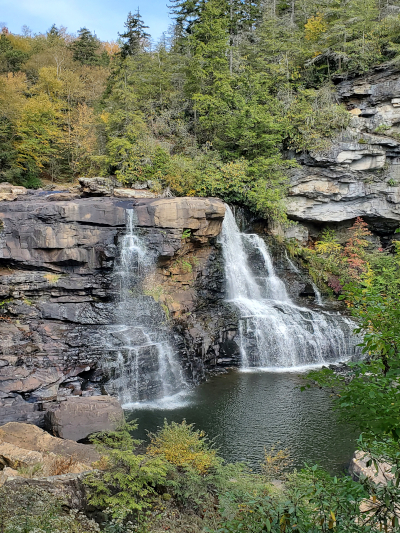
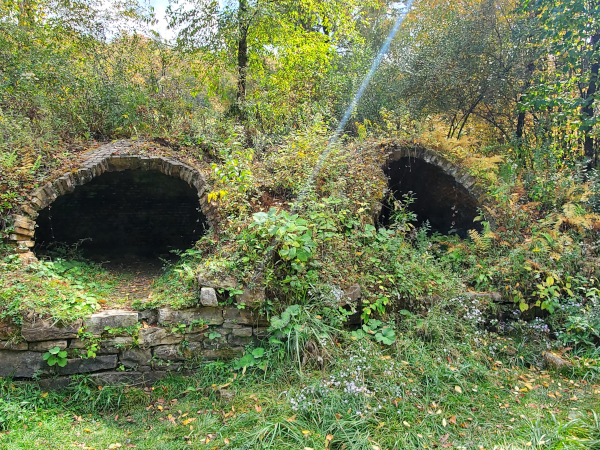
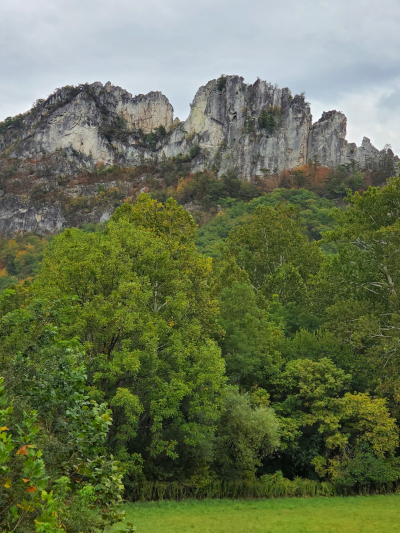
Blackwater Falls from the right bank of the river, the Coke ovens near the historic site of Douglas, and Seneca Rocks
Our first morning in town, we walked across the street to Milo’s Café and Restaurant for breakfast. I enjoyed their breakfast burrito and coffee. Our first hike in Blackwater Falls State Park took us along the Yellow Birch Trail from the horse barn and parking lot to the Blackwater Lodge. From there, we took the Elakala Trail to view Elakala Falls, then continued on the Balance Rock Trail before returning via Red Spruce Trail to the barn and parking area. It was a beautiful sunny day and a rewarding hike. Right away, the Yellow Birch Trail eliminates about half of Americans from the hike by squeezing through a narrow slot between two huge rocks. It’s a quiet, secluded trail that’s quite relaxing, though the root-covered surface requires vigilance. Things get busier and steeper near Blackwater Lodge, where there are several nice viewpoints. Balance Rock wasn’t as impressive as the name suggests, but it made a good lunch stop. On the way out of the park, we took the short Gentle Trail to view Blackwater Falls from across the river.
We explored Thomas in the afternoon, stopping at The Purple Fiddle for drinks and a light lunch. We listened to a guitarist—he wasn’t very good, but still fun—while sharing a Wild Turkey Wrap. We picked up coffees at TipTop before climbing the steep stairs from Ash Alley to Appalachian Highway, back to our parking spot.
The next day, we returned to Blackwater Falls to view them from the opposite bank. It was a short 0.4-mile loop with a lot of stairs, but the falls were beautiful. From there, we drove down Douglas Road out of Thomas in search of Douglas Falls. It turned out we were one road off. After parking and hiking for a bit, I turned around and took the next road closer to the river—Rail Falls Road, which becomes Blackwater Canyon Trail. That brought us to the old site of Douglas, across the Iron Pony Bridge, and to the trails to Douglas and Albert Falls. Douglas Falls was accessed via a short, steep rock scramble near the start. Most people stopped there, so hiking farther along Blackwater Canyon Trail was peaceful. We found the unmarked trail to Albert Falls, which was rustic and steep. Kathy stayed on the main trail while I descended to explore the falls. The climb back up was an excellent aerobic workout. On the way back along Rail Falls Road, we stopped to see the old coke ovens that line both sides of the former railroad bed.
We chose The Smokehouse at Blackwater Falls Lodge for dinner. The large windows surrounding the dining room provided a beautiful view of the grounds and gorge. Pizza seemed to be their main attraction, but we were craving salmon. Unfortunately, some kitchen equipment was down, so that wasn’t an option. We settled for the BBQ half chicken instead. It was good, but not exceptional.
On a rainy day, we decided to take a driving tour. We headed through the Canaan Valley, passed through Canaan Valley Resort State Park (there wasn’t much to see; the ski lift runs only on weekends), and continued through Harman. There we turned southeast toward Seneca Rocks and stopped at the Discovery Center. Seneca Rocks was striking and popular with climbers. Had the weather been better, we would have hiked there. From Seneca Rocks, we drove northeast through Hopeville to Petersburg, where I refueled and we stopped at El Jaripeo, a Mexican restaurant. I had the Pollo Aztec; Kathy had the Pollo Mole. Both were excellent, and we washed them down with margaritas. From Petersburg, we headed north through Maysville until we reached WV-48, then took that back to Davis. It made a lovely loop tour. We agreed that Davis was the best base camp among the small towns in the region. To stretch our legs after the drive, we explored the Riverside Trail behind our Airbnb from one end of town to the other.
The crazy traffic and crowding of the Richmond area in Virginia were a rude shock after the quiet charm of the Allegheny Highlands. Part two of our vacation was nonetheless enjoyable—visiting Mom and Dad, my sister and her family, meeting Dad’s caregiver, and getting to know my parents’ walking trails and favorite shops. We took a day trip to West Point, Virginia, for lunch at the Blue Crab, where I ate too much She-crab soup (it was very rich) and split Brussels sprouts with Kathy. The women did some shopping while Dad and I walked down to enjoy the view of the confluence of the Pamunkey and Mattaponi Rivers as they form the York River.
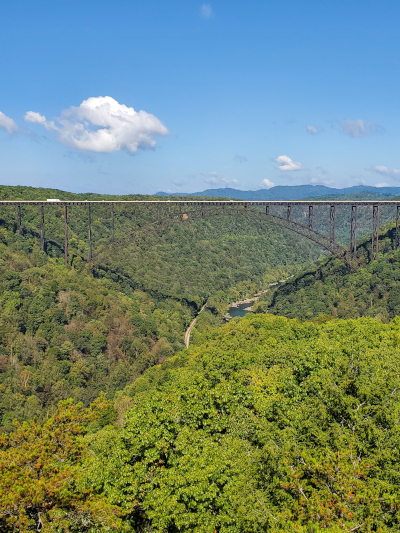
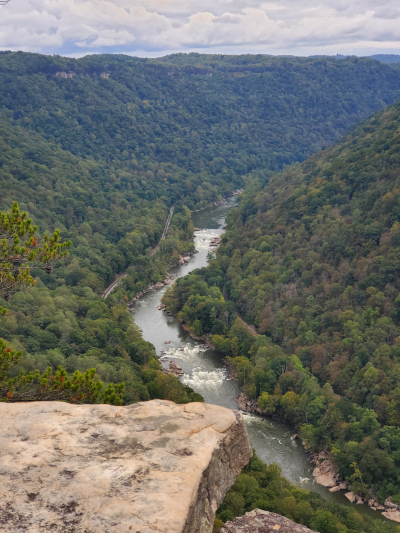
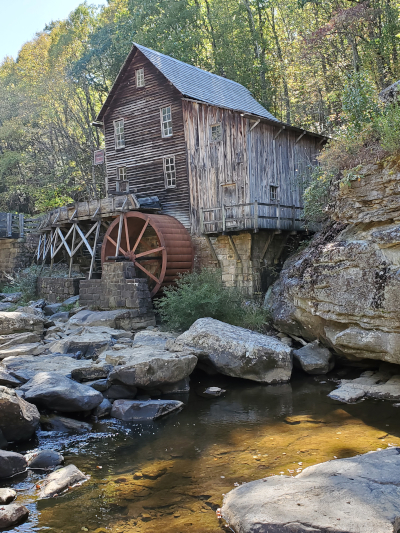
New River Gorge Bridge; New River Gorge from the Endless Wall Trail; Glade Creek Grist Mill at Babcock State Park
We returned to West Virginia for part three of our vacation, this time to the New River Gorge region. Our first Airbnb was secluded and comfortable, located in the tiny hamlet of Gatewood. Google Maps had a bit of trouble finding it from the east, taking us down Fayette Station Road, an eight-mile, one-way twisting road under the New River Gorge Bridge. We crossed the narrow Tunney Hunsaker Bridge and climbed back up the other side. It was a beautiful drive, and I’m glad Google made the mistake. Some turns were so sharp we barely made them with the truck! Once we emerged from the gorge, Google did a better job locating our Airbnb.
The Long Point Trail, with its overlooks of the New River Gorge and bridge, was our hike for the day. We started late due to dense fog. The trails here were busier than those in Blackwater Falls. We enjoyed the shorter 3.1-mile trail, though it was getting warm by the time we finished. We explored Fayetteville and had lunch at the Tequila Taco Bar. The Oaxacan chicken and margaritas were both excellent.
The next day’s destination was the historic town of Thurmond. We walked through the ghost town and old residential area, then crossed back over the river to the Rend Trailhead. The Rend Trail follows an old rail bed and is an easy walk, though I made it more challenging by detouring down the Church Loop to the First Baptist Church of Thurmond. The second half of the loop was overgrown and eventually disappeared, so I had to bushwhack back to the main trail. Later, I descended the steep Arbuckle Connector Trail to the Brooklyn Southside Trail to see the moss-covered rock walls and the remains of an old coke oven. The climb back up was a serious workout. We returned to the truck, stopping on the way back to town to see a small roadside waterfall.
We checked into our next Airbnb in downtown Fayetteville, giving us easy pedestrian access to restaurants and shops. We chose the Secret Sandwich Society for dinner, where I had a burger (sans bun) and truffle fries. They have quite a variety of sandwiches, each with a creative twist.
The following day, we hiked the Endless Wall Trail, beginning at the Fern Creek Trailhead about five minutes away. A light drizzle greeted us, but it quickly passed, leaving us a cool and pleasant hike through rhododendron forests with stunning overlooks of the gorge. Rock climbers descended from some of the turnouts. The trail itself was fairly easy, and rather than retracing our steps, we walked 0.5 miles along the road to return to our starting point. That evening, we found ourselves once again at the Tequila Taco Bar for dinner. I had the taco flight—two chicken and two beef tacos, each with a different sauce—and was glad for the short walk back to the Airbnb afterward.
For our final day in the area, we chose a hike to the Nuttallburg Headhouse, a short but steep trail beginning at the Short Creek parking lot. The path descended to the headhouse and coal mine, where we could view the old equipment used to transport coal from the mine to the valley floor below. After climbing out, we drove to Babcock State Park to see the Glade Creek Gristmill and surrounding cascades. It was a pretty setting, though the water was low. From there, we traveled south and west along winding roads to cross the New River at the Thomas Burford Pugh Memorial Bridge before completing the loop back to Fayetteville.